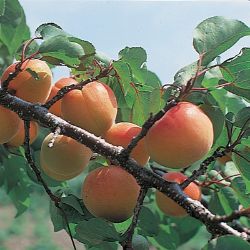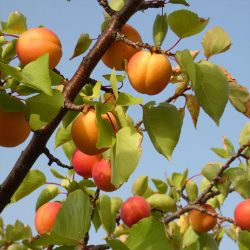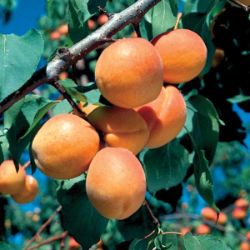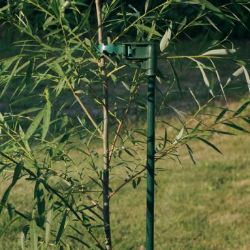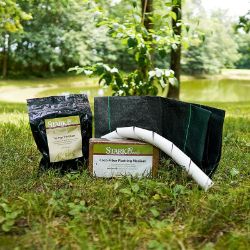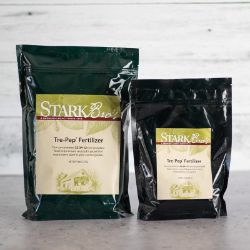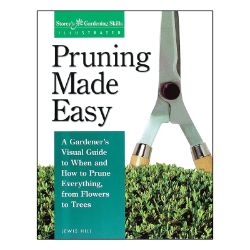Pest & Disease Control for Apricot Trees
As it grows, an apricot tree may experience issues such as the presence of pests or diseases. Factors such as location, weather, and upkeep play a part in which issues your apricot tree encounters and how well it stands up against them. Disease-resistant apricot trees are easy-care options for growers who prefer a low-spray or no-spray orchard, and – for all apricot trees – routine maintenance* can help keep most problems at bay.
*Examples of good practices are: adequate watering, fertilizing as needed, seasonal pruning, preventative and active spraying, fall cleanup, and winter protection.
NOTE: This is part 7 in a series of 11 articles. For a complete background on how to grow apricot trees, we recommend starting from the beginning.
The following are merely intended as a means of identifying potential issues. Don’t be alarmed – an apricot tree may experience a few of these in its lifetime, but certainly not all at once.
Apricot Tree Pests
Aphids
Tiny, pinhead-sized insects, varying in color depending on the type. Will cluster on stems and under leaves, sucking plant juices.
Symptoms: Leaves curl, thicken, yellow, and die. Aphids produce large amounts of a sticky residue called “honeydew” that attracts insects like ants. Honeydew becomes a growth medium for sooty mold.
Control: Spray
- GardenTech® Sevin® Concentrate Bug Killer
- Monterey Fruit Tree Spray Plus
Control: Natural Spray
- Monterey Fruit Tree Spray Plus
- Monterey Horticultural Oil
- Safer® Brand Insect Killing Soap
- Monterey Complete Disease Control
- Natural Guard® Neem
- Ferti-lome® Triple Action
Borers
Twig Borers – Brown grubs (larvae). Trunk Borers – Cream-colored grubs with brown heads. Often discovered after trunk injury has occurred.
Symptoms: Twig Borers overwinter, emerge in spring, and bore into tender limb tips. Injury causes shoot dieback and gummy residue. Grubs enter fruit later on during growing season. Pest does not cause extensive damage to the tree as Trunk Borers do. Trunk Borers cause a thick, gummy substance (sap) leaking from round holes on the trunk or in a crotch of the tree. Grubs tunnel through trunks and prolonged injury will weaken and eventually kill the tree. Difficult to control once trunks are infested. Preventative control measures to avoid infestation are highly recommended.
Control: Spray
- GardenTech® Sevin® Concentrate Bug Killer
Control: Natural Spray
- Hi-Yield® Vegetable & Ornamental Insect Control
Control: Manual
- Use a fine wire to try and mash or dig borer grubs out.
Japanese Beetle
Adult is a metallic-green and brown beetle, which skeletonizes leaves. Larvae are cream-colored grubs that feed on turf roots prior to maturity. Turf pest-control may help reduce grub populations; check turf product labels for timing and control of grubs. Traps are an option for luring adult beetles.
Symptoms: Adults are often seen in groups – large infestations can cause stunted growth and stress by skeletonizing a majority of the leaves.
Control: Spray
- GardenTech® Sevin® Concentrate Bug Killer
- Monterey Fruit Tree Spray Plus
Control: Natural Spray
- Hi-Yield® Vegetable & Ornamental Insect Control
Control: Manual
- If infestation is minimal, knock Japanese beetles into a jar of soapy water solution (they will become immobile when frightened as a defense mechanism)
Leafroller
Pale yellow or green worms.
Symptoms: Leaves are rolled and webbed together where grubs feed. Foliage eventually becomes skeletonized with prolonged exposure to feeding.
Control: Spray
- GardenTech® Sevin® Concentrate Bug Killer
- Monterey Fruit Tree Spray Plus
Control: Natural Spray
- Monterey Horticultural Oil
- Hi-Yield® Vegetable & Ornamental Insect Control
- Natural Guard® Caterpillar Killer Spray w/BT
- Ferti-lome® Triple Action
- Natural Guard® Neem
- Monterey Fruit Tree Spray Plus
Mites
Pinpoint-sized arthropods, appearing in many different colors depending on the type. Often found on undersides of leaves.
Symptoms: Sap feeding causes a bronze appearance in leaves. Severe infestations exhibit some silken webbing. Droughts or dry spells are advantageous for mite infestations.
Control: Spray
- GardenTech® Sevin® Concentrate Bug Killer
- Monterey Fruit Tree Spray Plus
Control: Natural Spray
- Monterey Horticultural Oil
- Safer® Brand Insect Killing Soap
- Ferti-lome® Triple Action
- Natural Guard® Neem
- Monterey Fruit Tree Spray Plus
Oriental Fruit Moth
Gray moth, 1/2-inch long. Larvae are white to cream with a brown or black head, 1/2-inch long. Only a slight difference in appearance from Codling Moth larvae.
Symptoms: Larvae bore into fast-growing tender twigs in spring and summer. Damage is similar to that of Twig Borers. Characteristic dieback of infested limb tips. Early fruit infestation by grubs results in fruit drop. Young fruit infestation is accompanied by entrance holes and gummy substance oozing from fruit. Mature fruit infestation is accompanied by inconspicuous stem-end entrance and tunneling through fruit flesh and around pit. Traps are an option for luring adult moths.
Control: Natural Spray
- Monterey Horticultural Oil
Plum Curculio
Adult is brownish gray, 1/5-inch long, hard-shelled beetle with a long snout and 4 humps on its back.
Symptoms: Cuts a crescent-shaped hole in fruit skins and lays eggs inside. Grubs hatch and tunnel within fruit. Fruit may drop prematurely or have grubs/worms or tunnels inside at harvest.
Control: Site Cleanup
- Thin crescent-shape scarred fruit as soon as it appears
- Remove dropped fruit as soon as it appears to avoid re-infestation
Control: Natural Spray
- Natural Guard® Neem
Scale
Usually on bark of young twigs and branches, encrusted with small (1/16-inch) hard, circular, scaly raised bumps with yellow centers. May also be on fruit.
Symptoms: Sap feeding weakens the tree.
Control: Spray
- GardenTech® Sevin® Concentrate Bug Killer
Control: Natural Spray
- Monterey Horticultural Oil
- Natural Guard® Neem
Tent Caterpillar
Adults are moths. Caterpillars are a hairy, grayish brown with cream-colored spots or stripes down the back.
Symptoms: Encases large areas in webbing and feeds on enclosed leaves.
Control: Site Cleanup
- Remove webs with a rake (caterpillars are removed with webs) and burn
Control: Natural Spray
- Monterey Horticultural Oil
- Hi-Yield® Vegetable & Ornamental Insect Control
Thrips
Tiny, slender, fringed-wing insects ranging from 1/25-inch to 1/8-inch long. Nymphs are pale yellow and highly active. Adults are usually black or yellow-brown, but may have red, black, or white markings.
Symptoms: Feeding occurs on vegetation by puncturing and sucking up the contents causing appearance to be deformed or discolored (similar to damage by mites and lace bugs).
Control: Natural Spray
- Monterey Fruit Tree Spray Plus
- Safer® Brand Insect Killing Soap
- Monterey Horticultural Oil
Apricot Tree Diseases
Bacterial Canker
Caused by Pseudomonas syringae – a bacterium that is spread by splashing rain or irrigation. Cool, wet weather and late frosts after blooming favor disease development.
Symptoms: Appears on branches and trunk as gummy cankers and water-soaked areas in spring. Brown leaf spots become shotholes in foliage in summer. Fruit develops dark, deeply sunken, sour-smelling areas, causing them to be more susceptible to Brown Rot.
Control: Site Cleanup
- Prune limbs back to healthy tissue (below canker). Disinfect shears between cuts with alcohol wipes or a solution of one-part bleach and ten-parts water.
- Remove and destroy pruning debris (do not mulch)
- Carefully cut away all cankered areas
- Consider painting pruning site with a tree-wound dressing to protect against re-infection
Control: Manual
- Plant disease-resistant trees whenever possible. Avoid susceptible (plum) rootstocks. Lovell (peach) is resistant.
- Maintain healthy, vigorously growing trees (through pruning and soil maintenance) to reduce susceptibility
- Test soil for nutrient deficiencies and feed as needed with soil additives, particularly nitrogen
- Test soil for ring nematodes in areas susceptible to canker (ring nematodes stress and weaken apricot trees, leaving them susceptible to canker)
- Avoid planting where ring nematodes are, or where canker-diseased trees previously were
- Prune in late summer when tissues are resistant to disease re-contamination, as opposed to typical winter/early spring pruning
Additional Resources
- Contact local county cooperative Extension for further advice (especially regarding soil testing, treatment, and replanting).
Bacterial Leaf Spot
Caused by Xanthomonas campestris – a bacterium that is spread by splashing rain and favors cool to warm temperatures. Also known by the names bacteriosis, black spot, and shothole.
Symptoms: Initially difficult to differentiate symptoms from nutrient (nitrogen) deficiency and chemical (spray) injury. Spots appear on the fruit, leaves, and twigs – including cankers. Purplish, black or brown spots appear on underside of leaves. Often the spots fall out, leaving small holes in the foliage, hence the name shothole. Holes will have a red halo around them. Leaves may turn yellow and fall. Infected fruit presents with spots, sunken areas, and oozing gummy residue. As the fruit continues to grow, the spots become cracks. Likelihood of disease-induced fruit drop is high. Severe defoliation affects fruit size, causes sunscald, and stresses trees going into winter. Cankers develop slowly (sometimes over several years if left untreated), growing larger and deeper. Deforms small branches, giving them a knotted appearance, and weakens them, causing breaks, tears, or dieback.
Control: Site Cleanup
- Plant resistant varieties if possible and keep a clean, well-maintained growing site
- Remove infected fruit and pruning debris from planting site
Additional Resources
- Due to sensitivities, do not use sprays on apricot trees that are not recommended for controlling bacterial spot and are not specifically intended for use on apricot trees.
- Contact local county cooperative Extension for further advice regarding apricot-safe chemical control recommended for your location.
Brown Rot
Caused by Monilinia fructicola – a fungus that is spread by wind, splashing rain, and favors warm, wet weather (typically during bloom period). Overwinters in mummified fruit, both on branches or on the ground around the planting site. Fungus is also produced in cankers on infected limbs for re-infection in favorable weather.
Symptoms: Affects blossoms, twigs, foliage, and especially fruit of most stone-fruit trees (Prunus). Blossoms will brown and wilt. Foliage presents with a blighted appearance. Cankers may appear on twigs. Fruit turns brownish with lighter spots. Fruit rots quickly, developing a sour smell and fuzzy gray/brown spores appear. Infected fruit mummifies and may drop or hang on the tree if not removed.
Control: Spray
- Hi-Yield® Captan 50W Fungicide
- Ferti-lome® Broad Spectrum Landscape & Garden Fungicide
Control: Site Cleanup
- Plant resistant varieties if possible and keep a clean, well-maintained growing site
- Remove and destroy infected (mummified) fruit and pruning debris from planting site
Control: Manual
- Prune to keep tree canopy open to light and air circulation, which naturally reduces risk of fungal infection
- Thin fruit clusters to reduce the risk of disease development between fruits that are touching
- Manually remove infected fruit as soon as it appears to reduce disease spread, as brown rot can cause complete fruit decay in as little as 2 days
Additional Resources
Coryneum Blight (Shothole)
Caused by Wilsonomyces carpophilus – a fungus that is spread by wind, splashing rain, and favors cool-to-warm, consistently wet weather (typically at shuck split in early spring). Overwinters in infected twigs and buds.
Symptoms: Small reddish-purple spots appear on young leaves and twigs. Leaf spots may feature small dark specks at lesion center. Spots enlarge, eventually dropping out of the leaf blade leaving a shothole-like appearance. Infected buds may be more easily winter killed. Appears on fruit, usually in clustered as light brown spots or lesions with dark purple margins. Fruit develops a rough, dry, corky texture.
Control: Spray
- Ferti-lome® Broad Spectrum Landscape & Garden Fungicide
Control: Site Cleanup
- Plant resistant varieties if possible and keep a clean, well-maintained growing site
- Prune out infected twigs, especially ones that are easier to find during dormant season
- Remove and destroy infected fruit and pruning debris from planting site
Control: Manual
- Prune to keep tree canopy open to light and air circulation, which naturally reduces risk of fungal infection
- Avoid overhead watering and consider ground-level, drip irrigation instead
Crown Gall
Caused by Agrobacterium tumefaciens – a bacterium that can persist without obvious tree symptoms for many years.
Symptoms: Trees appear stunted and slow growing; leaves may be reduced in size. In mature, fruit-bearing aged trees, may see little or no fruit. Woody, tumor-like growths called galls appear, especially at the crown (ground level). If tree has died, inspect roots for hard, woody tumors to identify crown gall as the cause. Symptoms in older apricot trees may be tolerated until trees succumb to the disease and are subject for removal. Younger trees can be removed earlier to start fresh with healthy trees. Note: Crown Gall is not the only thing that can cause stunted trees.
Control: Manual
- Avoid injury to tree, especially at planting time, as sites of injury are where the gall bacteria enter from the soil
- Test soil and seek advice specifically regarding crown gall from local horticulture experts
- Avoid planting in previously contaminated areas or where crown gall-infected orchards previously grew
- Remove all roots from trees that were removed and affected with crown gall in that location, or choose to plant clean plant material in a different location entirely
Additional Resources
- Contact local county cooperative Extension for further advice (especially regarding preventive dips/sprays in known affected areas prior to planting and steps toward planting new trees in a previously affected site).
Jacket Rot
Caused by Botrytis cinerea, Monilinia fructicola, Monilinia laxa, and Sclerotinia sclerotiorum – fungal pathogens that are spread by splashing rain, and favor wet weather (around bloom time and jacket stage when remnants of the flower parts are still attached to the fruit in spring).
Symptoms: Brown discoloration on the fruit under the flower jacket. Young fruit withers and falls off the tree. Looks like, but is separate from, winter injury to cold-sensitive small fruit, which also results in small, shriveled and brown fruit that drops.
Control: Spray
- Hi-Yield® Captan 50W Fungicide
Additional Resources
- Contact local county cooperative Extension for further advice
Powdery Mildew
Caused by Sphaerotheca pannosa and Podosphaera tridactyla – fungal pathogens that affect fruit and foliage in spring and then foliage again in summer and fall.
Symptoms: Whitish-gray powdery mold or felt-like patches on buds, young leaves, and twigs. Leaves may crinkle and curl upward. New leaves may be stunted, short and thin in structure. New shoots are stunted. As fruit infection progresses, white powdery appearance passes and brown to pink patches remain. Affected areas on fruit may harden and crack.
Control: Site Cleanup
- Control powdery mildew on nearby roses or stone-fruit trees (like peaches), as this is a common source of overwintering powdery mildew pathogens and early spring infection.
Control: Manual
- Plant mildew-resistant apricot trees whenever possible
- Prune to keep tree canopy open to light and air circulation, which naturally reduces development of most fungal infections
Control: Natural Spray
- Natural Guard® Neem
Scab
Caused by: Cladosporium carpophilum – a fungus that favors wet weather and humid, shaded areas with poor air circulation. Overwinters in infected twigs left on the tree or nearby trees from previous year.
Symptoms: Velvety and olive-green spots develop on young leaves, which eventually turn black. Affected leaves wither, curl, and drop. Fruit also presents with spots at the shoulder (stem end), and can become deformed, knotty, and cracked before it drops. Resembles, but is different from, bacterial spot. Note: Damage is generally superficial to fruit when scab infection is not severe enough to cause deformity. Fruit is still edible, simply remove the skin and either use for canning/freezing, or eat fresh.
Control: Site Cleanup
- Remove pruning debris and infected fruit at all times to avoid recontamination
Control: Manual
- Plant scab-resistant apricot trees whenever possible
- Prune, especially in early spring, to keep tree canopy open to light and air circulation, which naturally reduces opportunity for development of most fungal infections
Control: Spray
- Ferti-lome® Broad Spectrum Landscape & Garden Fungicide
Control: Natural Spray
- Natural Guard® Neem
Other Apricot Tree Issues
No Blossoms or Fruit
Symptoms: apricot trees take about 2 to 5 years after planting (on average) before they bloom or bear fruit. If enough time has been allowed to pass, and the apricot tree is otherwise healthy, there are a few things to do to help it become fruitful.
Control: Manual
- Make sure a pollinator variety is present. Most apricot trees require another different variety of apricot tree to be fruitful.
- Make sure your apricot tree variety is recommended for your zone. Low winter temperatures can injure sensitive fruit buds, hindering the potential for fruit production.
- Space trees far enough apart to help avoid nutrient or light competition. Adequate space encourages a healthy and productive tree. Spacing can be estimated by the mature spread of the tree.
- Prune to help keep the fruiting wood and vegetative wood in balance so that there isn’t too much leaf development in lieu of blossom development in mature trees – or too much fruit-bud development and not enough leaves to “feed” the fruit.
- Know your soil. Soil conditions, and the presence of necessary nutrients, help keep an apricot tree’s roots supplying nutrients through its vascular system. If the soil is poor, or poorly drained, this affects the health and viability of the tree as a whole. If the tree is being over-fertilized, especially with a fertilizer high in nitrogen, it may develop lush, vegetative growth (leaves and branches) instead of developing fruit buds or blooming.
Additional Resources
- Solving Fruit Tree Blooming & Bearing Problems
- Contact local county cooperative Extension for further advice
Sunscald and Sunburn (Scorching)
Scorching or sunburn occurs during hot, dry growing seasons – with or without humidity in the air, but most commonly when humidity is low. Brown, crispy edges appear on leaves.
Symptoms: Sunscald is also called winter injury or “southwest injury” as it commonly affects the south-west side of tree trunks during winter. Warm, clear days cause bark to expand and nights that are several degrees cooler will cause the bark to contract, damaging cells and causing splits and cracks in the trunk.
Control: Manual
- Protect trunks prior to winter with protective tree guards or a diluted solution of water and white latex paint (50/50).
- Water new trees every 7- to 10-days during the growing season (if no rain within the week) or as needed (as the soil becomes dry to the touch).
- During the growing season, consider constructing a temporary shade cloth to protect trees from the sun on hot, dry days. Water as needed (see above).
Additional Resources
Water Stress
Symptoms: Can relate to overwatering or underwatering. Overwatering commonly presents as pale green to yellow leaves and leaf drop. Can weaken a tree, lead to issues with root rot, and ultimately kill the tree. Underwatering often presents as discolored – often yellowed – dry leaves. Tree may appear to wilt overall and prolonged lack of water can kill the tree.
Control: Manual
- Water new trees every 7- to 10-days during the growing season (if no rain within the week) or as needed (as the soil becomes dry to the touch).
- If planted in a location where the soil does not adequately drain water after heavy rains (leading to standing water), relocate the tree as soon as possible.
- If drought-like conditions persist, consider slow-trickle drip irrigation to allow water to reach the roots rather than wash over soil surface.
Additional Resources
Wind Injury
Symptoms: Can involve injury such as leaning trees, uprooted trees, breaks, tears, or wind-burned foliage. Depending on the severity of the injury, an apricot tree can either bounce back from minor damage or succumb to the wind-caused harm. This is determined on an individual basis and the health of the tree before the damage occurred.
Control: Manual
- Adequately tamp soil around the tree’s roots (and thoroughly water) at planting time to remove air pockets and ensure good contact with the soil. Air pockets and loose soil around the roots can cause the tree to rock easily in its planting hole, leaving it vulnerable to leaning over or becoming uprooted.
- Use tree stakes for new trees, dwarf trees, and trees planted in high-wind areas to help support upright growth and avoid leaning, uprooting, and breaking.
- Selectively thin fruit that may be weighing down limbs to reduce stress from the weight, and avoid tears or breaks during gusty weather. Be aware: pests and disease may also take advantage of resulting broken or torn areas if damage occurs.
- If tender new foliage is blown or whipped around by the wind, it may appear discolored (dark – like a burn or bruise). This damaged growth can be removed to encourage healthy, new growth to take its place.













